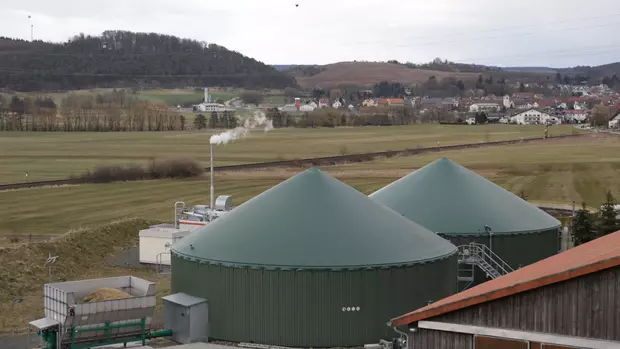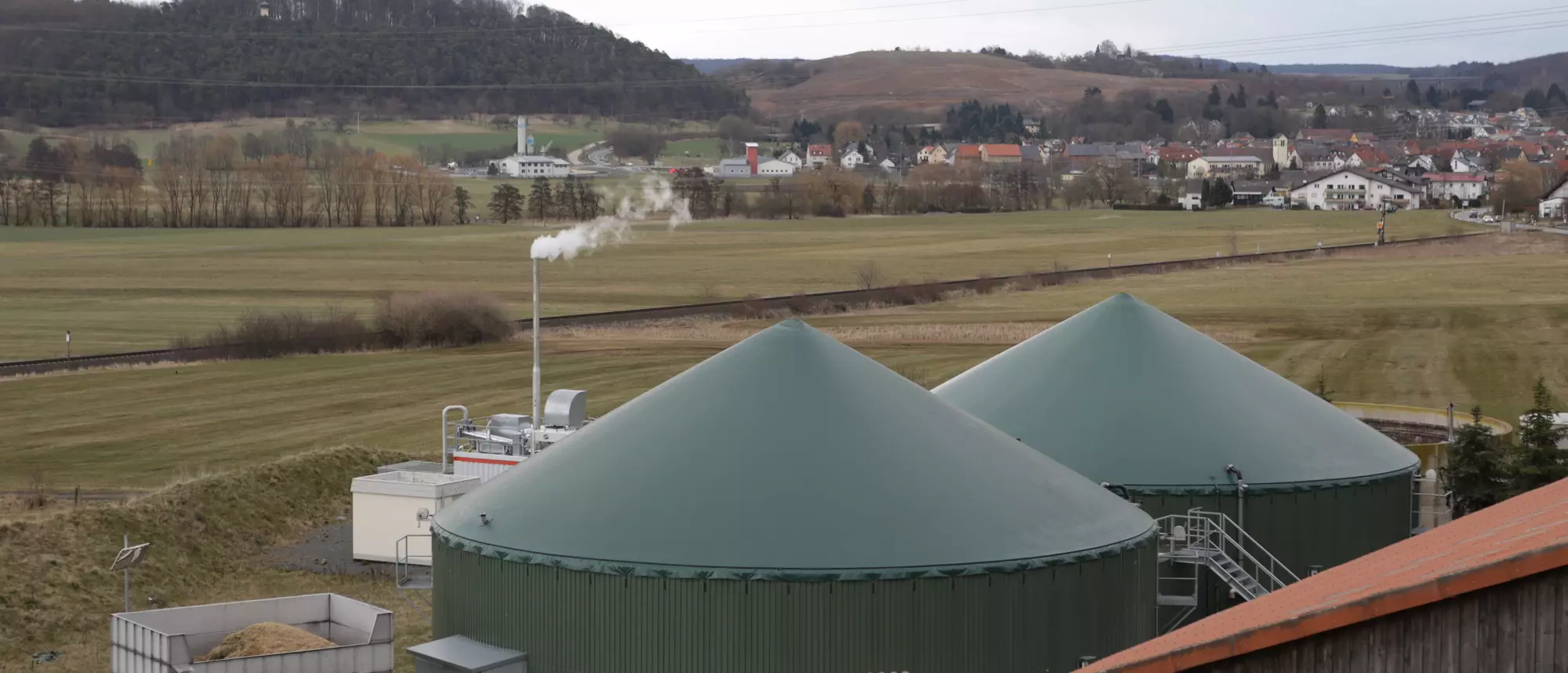
The industry magazine "Energie & Management" regularly presents the combined heat and power plant (CHP) of the month. In October, this award went to MIT.BIO Biogasanlage Großen-Buseck GmbH, in which Stadtwerke Gießen (SWG) holds a 51 per cent stake. SWG also operates the two CHP plants on the premises of the Klos agricultural business, co-partner and supplier of maize and grass for biogas production.
"Efficiency, sustainability and climate protection" are the characteristics of the plant, writes "Energie & Management" in the October issue. Key terms that Matthias Funk, Head of the District Heating Department at SWG, also considers essential: "Our concept is based on using raw materials from the region to produce heat and electricity directly on site. We also attached great importance to achieving the highest possible efficiency, which we succeeded in doing." Stefan Seibel, project manager in the district heating department, adds: "In terms of ecology and cost-effectiveness, the comparatively small-scale plant is one of the best in Germany."
Advantage of the heating network
Both CHP units have an electrical output of 185 kilowatts (kW) each and a thermal output of 275 to 300 kW each. The engines run efficiently and are particularly climate-friendly, partly because they have an additional heat exchanger that also utilises the exhaust gas heat and feeds it into the heating system. Only this technology enables a value of 275 kW and even 300 kW with the appropriate return temperature. This increases the thermal efficiency from 51 to 61 per cent compared to a CHP unit without an exhaust gas heat exchanger - and the overall efficiency to 97 per cent. Matthias Funk explains: "Fully utilising the heat from the gensets takes priority over feeding as much electricity as possible into the grid in accordance with the Renewable Energy Sources Act. In summer, we therefore only operate one of the two CHP units at a time."
The "fullest possible use" of the heat, as Matthias Funk puts it, is made possible above all by the nearby heating network in Großen-Buseck, which is around 1.5 kilometres long and has been operated by SWG in the municipality since 1995. Originally, a CHP unit and a gas boiler - both of which use natural gas as fuel - supplied the heating energy for the connected properties. Around 100 homes, the local school, the swimming pool and the sports hall are supplied via the heating network. Since the engines of the biogas plant have taken over heat production, the natural gas boiler only runs at peak load times. This includes the morning and evening hours during the winter months, for example.
A control system developed by Bosch regulates the use of the biogas plant's two CHP units - always in line with the heat demand. The specialists can also intervene manually at any time from the SWG control centre. "We had numerous levers at our disposal to improve efficiency and thus climate protection. Our success is based on the fact that we all made a few adjustments, even if this meant more effort than usual in some cases. But it was worth it. Because with the help of the economical model plant in Großen-Buseck, we can show what is possible when you set yourself high goals," emphasises Stefan Seibel.
Cooperation with science and research
The biogas plant is now helping to reduce CO2 emissions in the municipality by around 4,000 tonnes a year. This is also thanks to the cooperation with the Technical University of Central Hesse (THM) and the Justus Liebig University (JLU). Scientists from THM and JLU worked together with the municipal utilities to optimise the fermentation processes in the biogas plant - in other words, to increase the fuel yield from the existing cattle manure, maize and grass. Only this step made it possible to produce enough biogas for two CHP units with a relatively small plant.
"Sure, you could have installed a larger digester," says Stefan Seibel. However, this would have meant losing sight of a key requirement. After all, the goal was to procure all raw materials from the local area while avoiding monocultures.
Important insights gained
SWG intends to use the experience gained during the construction and operation of the biogas plant in Großen-Buseck to further promote the energy transition in the region. The strategy is to utilise existing local resources instead of relying exclusively on fuel from the Middle East or Russia. In Heuchelheim, the municipal utilities have therefore built a second biogas plant this year, for which the same standards apply as in Großen-Buseck.
Trial operation is currently underway. Cattle slurry and manure from the farm of local farmers Torsten and Hans Klug as well as grass and maize silage are used for biogas production - in a ratio of 60 to 40. The following also applies to the new plant: in order to cover the demand for maize and grass for fermentation, it is sufficient to expand the respective cultivation areas only to a small extent. Access and delivery routes as well as the optimal mix of biomass played a decisive role in the planning. SWG also worked together again with the Technical University of Central Hesse to optimise the fermentation processes.
With the help of biogas, the CHP plant on the site will generate more than 2 million kilowatt hours (kWh) of electricity per year in future - enough to meet the needs of around 600 households. The CHP plant also produces over 3 million kWh of heat per year. Enough to supply around 160 single-family homes in the neighbourhood with renewable energy from the region. There are plans to connect the plant to the district heating network of the Rinn & Cloos company and to the heating network of the construction site near the swimming pool.
Following the examples of Großen-Buseck and Heuchelheim, the municipal utilities want to tackle further projects in the future - but always with the maxim that Matthias Funk considers important: "Biogas is part of SWG's energy mix. On the scale that we use it today and in the future, it makes perfect sense - economically, ecologically and in the interests of the population."

